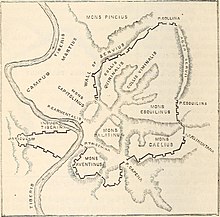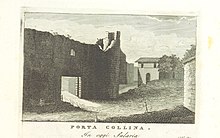Porta Collina
41°54′26.42″N12°29′55.37″E/ 41.9073389°N 12.4987139°E


TheColline Gate(LatinPorta Collina) was a landmark inancient Rome,supposed to have been built byServius Tullius,semi-legendaryking of Rome578–535 BC. The gate stood at the north end of theServian Wall,and past it were two important streets, theVia SalariaandVia Nomentana.Within this area theAlta Semitalinked theQuirinalwith thePorta Carmentalis.[1]Several temples were located near the gate, including temples ofVenus Erycina[2]andFortuna.To a person facing the gate in the 3rd century AD, theGardens of Sallustwould have been on the left, with theBaths of Diocletianon the right.[3]
Plutarchsays that, when aVestalwas punished for violating her vow of chastity, the subterranean chamber for her live burial was near the Colline Gate.[4]The gate was thesite of a decisive battleduring theRoman civil wars of the 80s BCbetween the forces ofCinnaandSulla.[5]
References
[edit]- ^Sarolta A. Takács,Vestal Virgins, Sibyls, and Matrons: Women in Roman Religion(University of Texas Press, 2007), p. 88.
- ^Elaine Fantham,commentaryonOvidFastiBook IV(Cambridge University Press, 1998), p. 255online.
- ^Kim J. Hartswick,The Gardens of Sallust: A Changing Landscape(University of Texas Press, 2004), p. 143online.
- ^For the passage in its dreadful entirety, see Takács,Vestal Virgins,p. 87online;discussion pp. 88–89.
- ^Michael Lovano,The Age of Cinna: Crucible of Late Republican Rome(Franz Steiner Verlag, 2002), p. 129ff.online.
